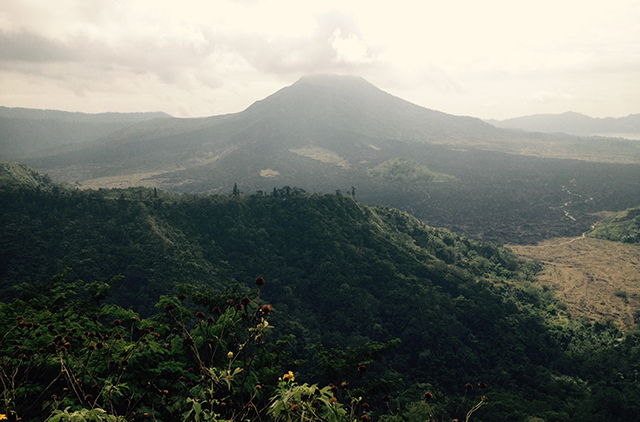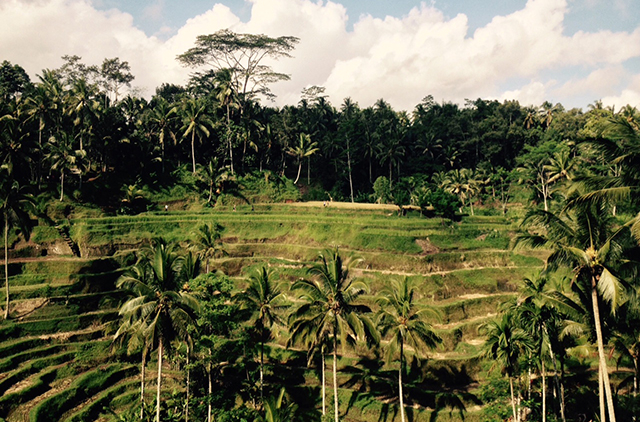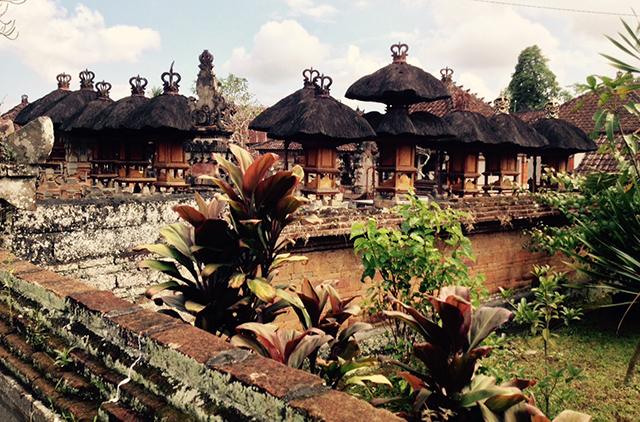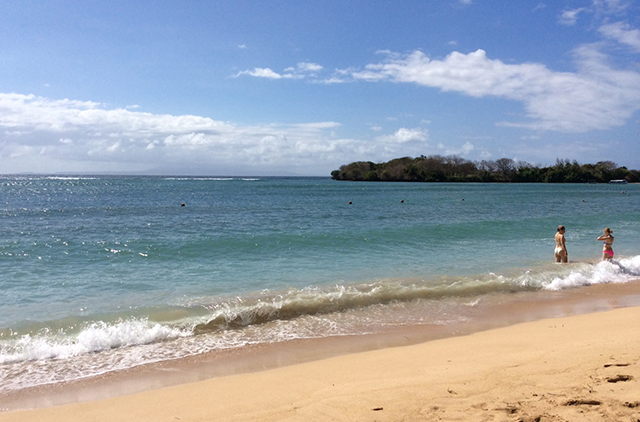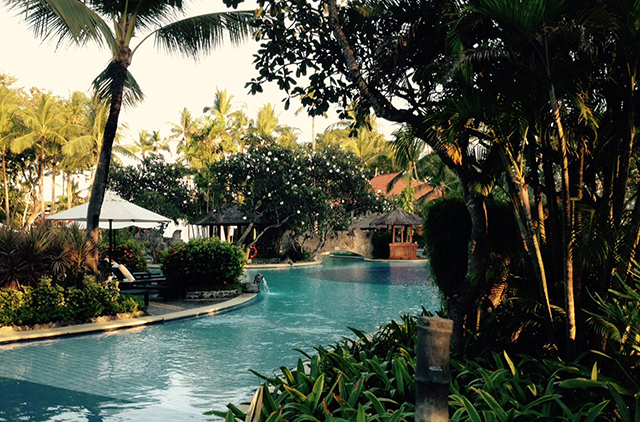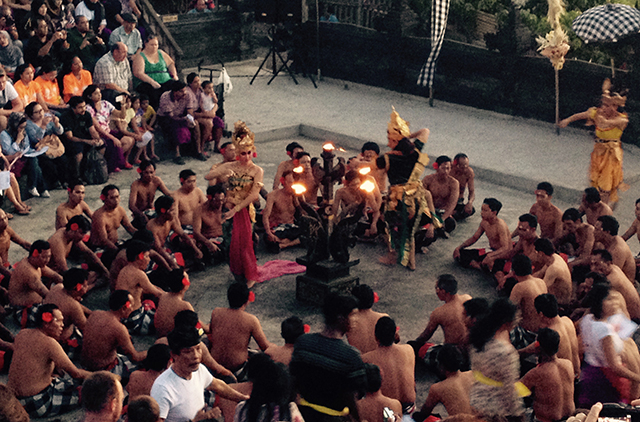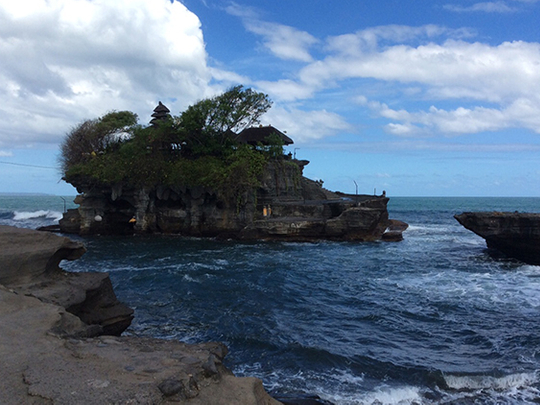
“Om Swastiastu,” says the beaming old man clad in a golden Batik shirt as we step out to the aerobridge, his palms pressed together and his face breaking into a thousand blissful wrinkles. He is one of the dozens of Indonesian tourism staff who have lined up to greet us at the Denpasar International Airport in Bali.
Think Bali and your mind conjures up silvery waves, strings of volcanic mountains girdled by scenic forests, spectacular surfing beaches, rice terraces and ancient cliff-side temples dispensing instant nirvana to visitors.
But the first thing that resonates as you step out of your flight is the warmth of the Balinese people, welcoming you with the familiarity of decades. And since this is Emirates Airline’s inaugural direct flight from Dubai to Bali, we are serenaded by a troupe of Legong dancers and a musical ensemble at the immigration hall, instead of the dour passport officer greeting us at the counter.
The pampering continues right up to the hotel, with big smiles and a bigger garland of yellow tuberose that await us at the gargantuan lobby of the Melia Hotel in Nusa Dua, one of Bali’s most enchanting enclaves.
Here, dozens of voices and the mellifluous music merge in another chorus of “Om Swastiastu” – welcome to Bali (literally, though, this means May God bless you)!
Indonesia is a land of thousands of islands, with almost 10,000 of them inhabited and each of them an adventurer’s delight. But among them, Bali has catapulted to the pinnacle of public imagination thanks not only due to its natural bounty and friendly faces, but also its vibrant arts and music scene and the exquisite woodworks, metal and stone carving industries.
According to the Indonesian Tourist Board, about 80 per cent of the nearly 10 million annual tourists to the country visit only Bali. Lying between Java and Lombok, Bali is one of Indonesia’s 33 provinces with a capital at Denpasar in the south. While the beachside of Kuta is the vibrant party heartland of the island and Jimbaran Bay is the dream of every diehard romantic soul, Seminyak, Sanur and Nusa Dua are popular but secluded resort towns.
Step away from this populist streak towards the north or the east, and you can discover a very different Bali – from black sandy volcanic beaches to the holiest of the island’s many thousands of temples, Pura Besakih. At once soulful and sensuous, Bali is a holiday experience hard to define.
The author Lionel Shriver found in Bali an island with an “unhurried” soul. Heston Blumenthal – arguably one of the world’s best chefs – says he had one of his most memorable meals on the beaches of Bali: a chicken wrapped in banana leaf with a salt-crust pastry with black volcanic sand.
It’s an island with a long history of embracing tourists. Lonely Planet founder Tony Wheeler recalls his first visit to the island in 1972, when Ubud – the cultural heart of Bali – had no electricity and barely any paved roads.
Cut to the modern day, and whether you are meandering through the dusty alleys of Ubud Market or the manicured avenues of Nusa Dua, the decades of tourist footfall seem to have hardly impacted traditional life in the island, though the mainstay of the Balinese economy is still tourism.
Perhaps the secret to preserving the true essence of Bali is in the contentment that lies at the heart of the land. From the freckled farmer at the rice terrace to our beaming usher at the airport to our travel guide Dena – who patiently unravels the secrets of paradise to the uninitiated – everyone in Bali looks reasonably pleased with their lives, no matter the circumstance.
And the mundane and the sublime mingle most poignantly as you tiptoe your way around the numerous Canang Saris strewn on the streets – handwoven small baskets of palm leaves, filled with hibiscus petals, myriad hues of other flowers, grains of sticky rice and betel nuts, with the sweet smell of jasmine floating from incense sticks.
They are everywhere, the Canang Saris – placed in front of Ralph Lauren mannequins draped in polos and golf shorts, at the small shrines near street corners, at the doorstep of every supermarket, and even on the dashboard of bemos, the shared taxis. These are the daily Balinese offerings to their Hindu gods, multitudes of whom greet you at every street junction in the form of gigantic statuettes enacting scenes from the epics of Ramayana and Mahabharata.
A pocket of Hinduism in Muslim-majority Indonesia, the first Hindus arrived in Bali around 100BC. But the grain of Hinduism practiced in the island is indebted more to the Javanese version than what you would find in India.
On an earlier visit to the island last year, for instance, I watched a rather colourful funeral march – unlike in India, the Balinese celebrate every passing away as the ultimate transcendence of the soul.
It’s rather apt, considering that in many ways, a trip to Bali transcends the realm of your average escape to a tropical paradise. This is the realm where travel ends and discovery begins.
And the best part? That discovery is now only an eight hours direct flight away from Dubai.
Essentials
When to go: Today, next week or whenever ... Bali is an evergreen destination. The dry season runs from June until September, but the rest of the year it is less crowded and can be enjoyed easily.
Go there: Emirates flies daily from Dubai to Bali – flight EK398 departs Dubai at 8.20am and arrives in Bali at 9.40pm the same day; the return flight, EK399, departs at 11.40pm and arrives in Dubai at 5am the next day. Prices for a return ticket start at Dh3,495 for economy class. More details at emirates.com


